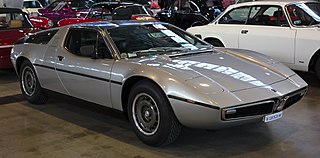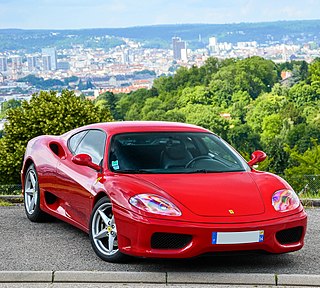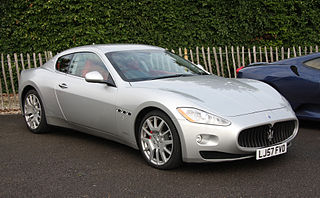
Maserati S.p.A. is an Italian luxury vehicle manufacturer. Established on 1 December 1914 in Bologna, Italy, the company's headquarters are now in Modena, and its emblem is a trident. The company has been owned by Stellantis since 2021. Maserati was initially associated with Ferrari. In May 2014, due to ambitious plans and product launches, Maserati sold a record of over 3,000 cars in one month. This caused them to increase production of the Quattroporte and Ghibli models. In addition to the Ghibli and Quattroporte, Maserati offers the Maserati GranTurismo and two SUV models, the Maserati Levante and the Maserati Grecale. Maserati has placed a yearly production output cap at 75,000 vehicles globally.

The Maserati Bora is a two-seat, rear mid-engine, rear-wheel drive sports car and grand tourer, manufactured by Maserati from 1971 to 1978. In common with other Maserati cars of the era, it is named after a wind, Bora being the wind of Trieste. The Bora was the company's first mid-engined street car and ended Maserati's reputation for producing fast but technologically out of date cars, also being the first Maserati with four wheel independent suspension. In contrast, competitor Lamborghini had first used full independent suspension in 1964. The Bora was the second-most expensive car of the 1970s following Lamborghini Countach.

The Ferrari 360 is a two-seater, mid-engine, rear wheel drive sports car manufactured by Italian automotive manufacturer Ferrari from 1999 until 2004. It succeeded the Ferrari F355 and was replaced by the Ferrari F430 in 2004.

De Tomaso Automobili Ltd. is an Italian car-manufacturing company. It was founded 1959 by Alejandro de Tomaso in Modena. It originally produced various sports prototypes and auto racing vehicles, including a Formula One car for Frank Williams Racing Cars in 1970. Most of the funding for the automaker came from Amory Haskell Jr.

The Ferrari 550 Maranello is a front-engine V12 2-seat grand tourer built by Ferrari from 1996 to 2002. The 550 Maranello marked Ferrari's return to a front-engine, rear-wheel drive layout for its 2-seater 12-cylinder model, 23 years after the 365 GTB/4 Daytona had been replaced by the mid-engined Berlinetta Boxer.

The Maserati Quattroporte is a four-door luxury sports sedan produced by Italian automobile manufacturer Maserati. The name translated from Italian means "fourdoors". The car is in its sixth generation, with the first generation introduced in 1963.

The Maserati 3200 GT is a four-seater grand tourer produced by Italian automobile manufacturer Maserati from 1998 to 2002, replacing the Shamal as the flagship grand tourer of the marque. The luxury coupé was designed by Italdesign, whose founder and head Giorgetto Giugiaro previously designed, among others, the Ghibli, Bora and Merak. Interior design was commissioned to Enrico Fumia and completed by 1995. 4,795 cars were produced before it was replaced by the Maserati Coupé.

The De Tomaso Guarà is a sports car and the last project the founder and owner Alejandro de Tomaso put into the market. Presented at the 1993 Geneva Motor Show, the Guarà was initially available in coupé body-style. Later a roadster and an open-top barchetta bodystyle became available. The latter corresponds to the coupé but without roof and proper windscreen; a small air deflector protects the passenger and the driver from the passing wind and the car had to be driven while wearing a helmet.

The Ferrari 250 Testa Rossa, or 250 TR, is a racing sports car built by Ferrari from 1957 to 1961. It was introduced at the end of the 1957 racing season in response to rule changes that enforced a maximum engine displacement of 3 litres for the 24 Hours of Le Mans and World Sports Car Championship races. The 250 TR was closely related to earlier Ferrari sports cars, sharing many key components with other 250 models and the 500 TR.

The De Tomaso Pantera is a mid-engine sports car produced by Italian automobile manufacturer De Tomaso from 1971 to 1992. Italian for "Panther", the Pantera was the automaker's most popular model, with over 7,000 manufactured over its twenty-year production run. More than three quarters of the production was sold by American Lincoln-Mercury dealers from 1972 to 1975; after this agreement ended De Tomaso kept manufacturing the car in ever smaller numbers into the early 1990s.

The De Tomaso Mangusta is a sports car produced by Italian automobile manufacturer De Tomaso between 1967 and 1971. It was succeeded by the De Tomaso Pantera.

The Maserati Kyalami is a four-seat GT coupé produced by Italian automobile manufacturer Maserati from 1976 to 1983. The car was named after the Kyalami Grand Prix Circuit in South Africa, where a Maserati-powered Cooper T81 won the 1967 South African Grand Prix.

The Maserati Biturbo is a family of executive grand tourers produced by Italian automobile manufacturer Maserati between 1981 and 1994. The original Biturbo was a two-door, four-seater notchback coupé featuring, as the name implies, a two-litre V6 engine with two turbochargers and a luxurious interior.

The Alfa Romeo 33 Stradale is a mid-engine sports car built by Italian automobile manufacturer Alfa Romeo. It was the fastest commercially available car for the standing kilometer upon its introduction. 18 examples were produced between 1967 and 1969. "Stradale" is a term often used by Italian car manufacturers to indicate a street-legal version of a racing car; indeed the 33 Stradale was derived from the Tipo 33 sports prototype. Built in an attempt by Alfa Romeo to make some of its racing technology available to the public, it was also the most expensive automobile for sale to the public in 1968 at US$17,000.

Maserati 150S is a racing car made by Maserati of Italy alongside the Maserati 200S, to take over for the aging Maserati A6GCS racing variants. Depending on the source, between twenty-four and twenty-seven examples were built, and one additional street-going car, called the Maserati 150 GT.

The Qvale Mangusta is a sports car produced in limited numbers by the Italian automaker Qvale between 1999 and 2002. During development and very early production, it was developed from the De Tomaso Biguá concept car shown to the general public at the 1996 Geneva Motor Show. When the car started production, it was renamed De Tomaso Mangusta before De Tomaso became disassociated from the project and all subsequent cars received Qvale badging.

Siata was an Italian car tuning shop and manufacturer founded in 1926 by amateur race car driver Giorgio Ambrosini.

The Maserati GranTurismo and GranCabrio are a series of grand tourers produced by the Italian manufacturer Maserati, succeeding the Maserati Coupé and Spyder.
Neri and Bonacini, also known as Nembo, was a small carrozzeria and mechanic shop based in Modena, Italy, active from the late 1950s to around 1967. Founded and run by Giorgio Neri and Luciano Bonacini, the shop worked on and produced bodies for Ferrari, Lamborghini and Maserati road and race cars, both in an official capacity for those manufacturers and for private owners. Their best known projects are the Ferrari 250 GT-based Nembo spiders and the Lamborghini 400GT Monza. Neri and Bonacini also designed a car under their own name, the Neri and Bonacini Studio GT Due Litri. Two prototypes of this car were made between 1966 and 1968 but it never entered series production. The shop closed around 1967 when Bonacini went to work for De Tomaso and Neri started his own shop, Motors-World-Machines (MWM).
Thomas Meade was an American automobile designer and dealer best known for his Thomassima series of custom cars based on Ferrari engines and chassis. He was based in Modena, Italy from the early 1960s through the early 1970s, where he met and collaborated with many Modenese carrozzerie, manufacturers and mechanics.



















